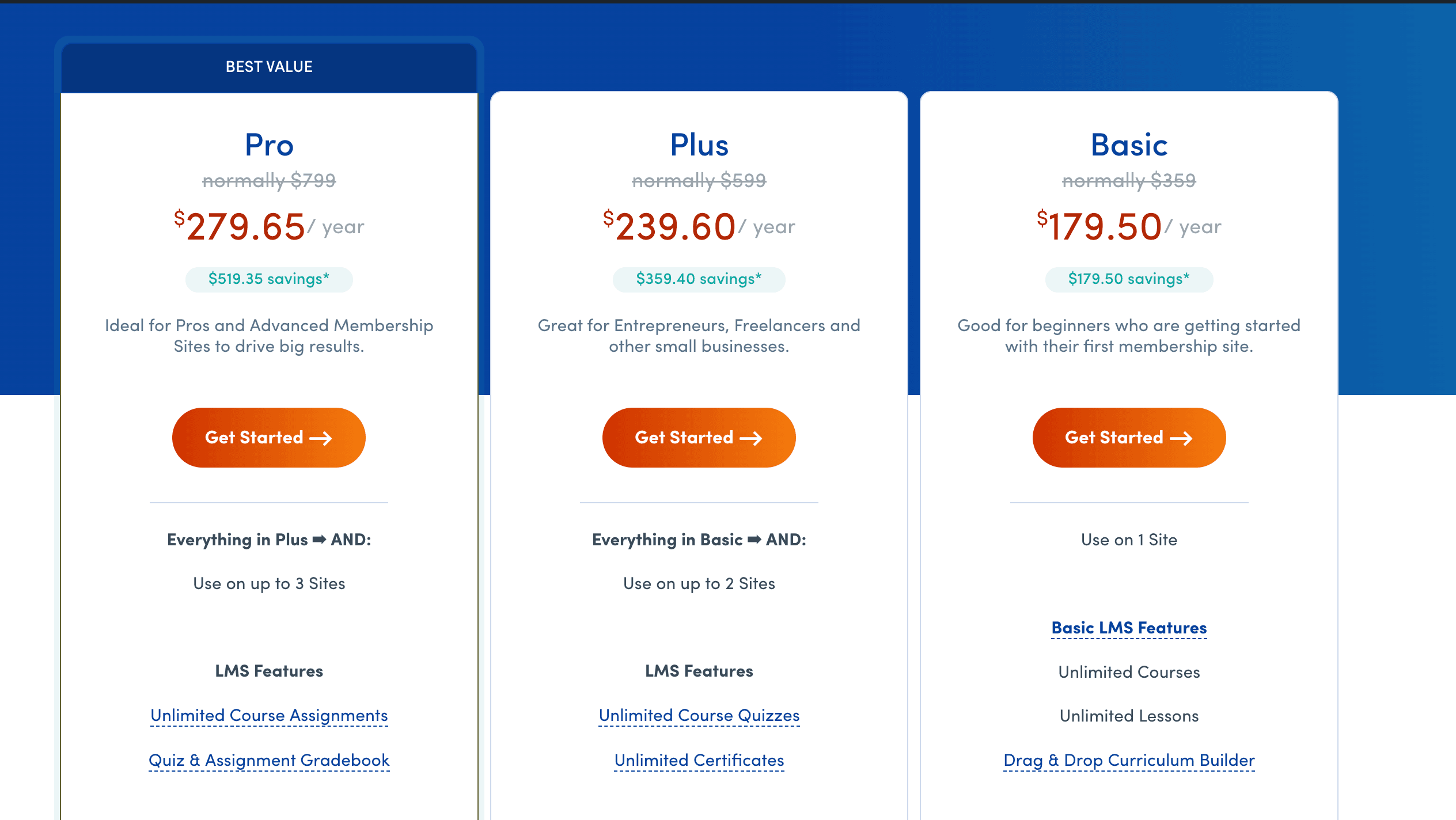Introduction and Overview: Designing Tiered Membership Models
When done right, a thoughtfully structured tiered membership model can transform your online business from a simple digital product into a thriving ecosystem of value-based offerings. As someone who’s helped hundreds of course creators optimize their pricing strategies, I’ve seen firsthand how the right tier structure can dramatically increase both revenue and student satisfaction.
Think of your membership tiers like a well-designed hotel: you have your standard rooms that meet essential needs, deluxe rooms with extra amenities, and luxury suites offering premium experiences. Each level builds upon the previous one, creating clear value distinctions that appeal to different segments of your audience. This same principle applies to your digital offerings.
The key to successful tiered pricing isn’t just about charging more for additional content – it’s about understanding the distinct needs and aspirations of different student segments. For example, a beginner might be perfectly satisfied with foundational course materials and basic community access, while an advanced student might crave personalized coaching calls and exclusive workshops.
Before diving into specific tier structures, it’s crucial to understand that your membership levels should reflect natural progression points in your students’ journeys. Consider a business coaching program: your entry tier might include pre-recorded training and monthly group calls, your middle tier could add bi-weekly hot seat sessions, and your premium tier might incorporate one-on-one mentoring and access to your inner circle mastermind.
The most successful tiered models I’ve seen maintain a delicate balance between accessibility and exclusivity. Your base tier should provide enough value to prove your expertise and deliver meaningful results, while higher tiers offer enhanced support, deeper engagement, and premium experiences that justify the increased investment.
Throughout this guide, we’ll explore proven strategies for structuring your tiers, pricing them effectively, and creating compelling value propositions that make upgrading feel like a natural choice for your members. We’ll also address common pitfalls to avoid and share real-world examples of successful tiered membership implementations that have generated substantial revenue growth for course creators.
Foundation Concepts and Planning
Before diving into the specifics of tiered membership structures, let’s establish the core foundations that will set you up for success. When done right, a tiered membership model can dramatically increase your revenue while providing genuine value at each level. The key is understanding that successful tiers aren’t just about charging different prices – they’re about creating distinct experiences that resonate with different segments of your audience.
Start by examining your current offerings and audience needs. What are the primary pain points your members face? What transformation do they seek? Map out how these needs vary across different segments. For instance, some students might want basic access to your content library, while others crave personalized coaching and community interaction. Understanding these distinctions will help you craft meaningful tier differentiation.
Consider the psychological aspects of pricing and value perception. Research shows that people often gravitate toward middle-tier options when presented with three choices. This “goldilocks effect” means your middle tier should be your target sweet spot – the option you expect most members to choose. Design your entry-level tier to provide clear value while naturally encouraging upgrades, and position your premium tier as the aspirational choice for those seeking the ultimate experience.


Think carefully about your operational capacity as you plan each tier. Can you sustainably deliver on premium promises? Will your support system handle an influx of members across different levels? It’s better to start with fewer, well-executed tiers than to overwhelm yourself with complex structures that become difficult to maintain. Remember that you can always expand your offerings as your systems and team grow.
Focus on creating clear value differentiation between tiers. Each level should offer distinct benefits that justify the price increase. Avoid the common mistake of simply adding more content – instead, think about how you can provide different types of value. This might include varying levels of access to you, exclusive events, priority support, or specialized resources. The goal is to make each tier attractive to its intended audience while maintaining healthy profit margins.
| Feature | Benefit | Use Case |
|---|---|---|
| Drip Content | Increases engagement | Course progression control |
| Quiz & Assessments | Validates learning | Student progress tracking |
| Certificates | Motivates completion | Professional development |
| Community Access | Builds loyalty | Student interaction |
Consider implementing a pilot program before fully launching your tiered structure. Select a small group of existing members or new customers to test your proposed tiers. Their feedback will be invaluable in refining your offerings and identifying potential operational challenges. This approach allows you to make adjustments before scaling, ensuring a smoother full-scale launch and higher member satisfaction across all tiers.
Step-by-Step Implementation Guide
When done right, implementing a tiered membership model can transform your online course business. Let’s break down the exact process you’ll need to follow to create membership tiers that genuinely resonate with your audience while maximizing your revenue potential.
Start by conducting thorough market research to understand what your target audience truly values. Survey your existing students, analyze competitor offerings, and identify clear pain points that different segments of your audience experience. This foundational work will help you create tiers that naturally appeal to distinct customer groups.
Next, design your entry-level tier as your accessibility option. This should include your core offering at a price point that feels achievable for most of your target audience. For example, if you’re teaching digital marketing, your basic tier might include foundational courses, monthly group coaching calls, and access to a community forum. Price this tier to attract new members while ensuring profitability.
Your middle tier should represent the sweet spot between value and price. This is where most of your members will likely land, so make it compelling. Build upon your basic tier by adding features that directly address common user challenges. Consider including additional live coaching sessions, priority support, or specialized workshops. The key is to make the upgrade feel like an obvious choice.
For your premium tier, focus on creating an exclusive experience that justifies the higher price point. This might include one-on-one mentoring, done-for-you services, or early access to new content. Remember that this tier isn’t just about adding more features – it’s about providing a truly transformative experience for your most committed members.
Implement a clear onboarding process for each tier. Create specific welcome sequences that highlight the unique benefits of each level and guide members toward their first success milestone. This early engagement is crucial for retention and helps members quickly see the value in their investment.
Develop a strategic upgrade path between tiers. Use automation to identify members who are highly engaged with their current tier and might be ready for more. For instance, if a basic member has completed all available courses and regularly attends group calls, they might be prime for an upgrade offer.
Finally, establish clear metrics to measure the success of your tiered model. Track conversion rates between tiers, engagement levels, retention rates, and revenue per member. Use this data to continuously refine your offerings and pricing strategy. If you notice members clustering in certain tiers or dropping off at specific points, adjust your value proposition accordingly.
Remember that your tiered structure should remain flexible enough to evolve with your business and your members’ needs. Schedule quarterly reviews to assess performance and gather feedback, ensuring your model continues to serve both your members and your bottom line effectively.
Advanced Strategies and Techniques for Tiered Memberships
Let’s dive deep into sophisticated strategies that can transform your basic membership tiers into a revenue-generating powerhouse. When done right, a well-structured tiered system creates natural progression paths that members actually want to follow, rather than feeling pressured into upgrades.
Start by implementing value-stacking in your higher tiers instead of simply offering “more content.” For example, if your base tier includes course access, your middle tier might add monthly group coaching calls and priority support. Your premium tier could then incorporate one-on-one sessions, done-for-you services, or exclusive mastermind groups. This creates clear differentiation that justifies price increases.
Consider implementing a strategic ascension model where members naturally graduate from one tier to the next. This might mean your entry-level tier focuses on fundamentals, while advanced tiers tackle more complex topics or offer deeper implementation support. Think of it as building a ladder where each rung serves a specific purpose in your members’ journey.
One often-overlooked technique is the creation of tier-specific community spaces. Rather than having everyone in the same discussion area, consider creating exclusive spaces for higher-tier members. This naturally showcases the enhanced value and engagement available at premium levels, while maintaining a positive experience for all members. Incorporating direct messaging and targeted coaching opportunities can further enhance this community-driven approach.
Leverage scarcity and exclusivity thoughtfully in your higher tiers. This might include limiting the number of spots in your top tier, offering early access to new content, or providing exclusive bonuses. However, ensure these limitations serve a genuine purpose rather than being artificial constraints.
Consider implementing a hybrid pricing model where members can either pay monthly with a higher recurring fee or annually with a significant discount. This flexibility often leads to higher overall retention while giving budget-conscious members a way to save money through longer commitments.
Another advanced strategy is creating “bridge” products or mini-courses that specifically address the gaps between tiers. These can serve as natural stepping stones, helping members see the value in upgrading while providing additional revenue streams. For instance, a “fast-track” program that helps basic members prepare for advanced material in higher tiers.
Finally, develop a robust analytics system to track member behavior and engagement across tiers. Pay attention to which features drive the most value, when members typically upgrade, and where they might get stuck. This data becomes invaluable for continuous optimization of your tier structure and pricing strategy.
Common Challenges and Solutions
When building a tiered membership model, you’ll likely encounter several obstacles that can impact your revenue potential. One of the most prevalent challenges is pricing paralysis – spending too much time trying to find the “perfect” price points while delaying your launch. Instead, focus on creating clear value differentiation between tiers and start with a simple three-tier structure that you can refine over time.
Unfortunately, many creators struggle with content organization across different membership levels. The key is to avoid the temptation to overcomplicate your offerings. Start by mapping out your core content and then strategically enhance it for higher tiers. For example, if your base tier includes recorded workshops, your middle tier might add live Q&A sessions, while your premium tier could feature one-on-one coaching calls.
Another common hurdle is managing member expectations and preventing subscription cancellations. Combat this by creating engagement milestones for each tier. Your basic members might receive weekly check-in emails, while premium members get personalized progress tracking and priority support. This tiered approach to communication helps members feel valued at every level while encouraging upgrades.
Technical implementation can also become overwhelming, especially when setting up automated access controls and content delivery. Consider using a staging environment to test your tier structure before going live. This allows you to identify potential issues with content access, payment processing, and member transitions between levels without affecting your active members.
Content overwhelm is another significant challenge that can paralyze your progress. Rather than trying to create all content for all tiers upfront, focus on developing a strong foundation for your base tier first. Then, gradually expand your premium content offerings based on member feedback and engagement data. This approach allows you to validate your content strategy while maintaining consistent delivery.
Finally, many course creators struggle with effectively communicating the value difference between tiers. The solution is to create clear, benefit-focused comparison charts that highlight the unique advantages of each level. Use specific numbers and tangible outcomes rather than vague promises – for instance, “4 live group coaching calls per month” instead of “increased support.” Remember that your pricing tiers should tell a coherent story about your members’ journey from beginner to advanced levels.
Best Practices and Optimization
When designing your tiered membership model, the key to optimization lies in creating clear value differentiation between levels while maintaining profitability at each tier. Start by analyzing your current content and services, then strategically distribute them across tiers in a way that naturally encourages upgrades. When done right, each tier should feel complete while still presenting compelling reasons to consider the next level up.
Begin with your pricing structure. A common mistake is setting arbitrary price points without considering the value-cost relationship. Instead, calculate your delivery costs for each tier, including time investment, platform fees, and resource allocation. Add your desired profit margin, then validate these numbers against market research and competitor analysis. Aim for a 3x-5x markup from your base costs to ensure sustainable operations.
Focus on creating distinctive features for each tier that align with your members’ journey. Your entry-level tier might include basic course access and community features, while mid-tier members could receive group coaching sessions and priority support. Reserve your highest tier for premium offerings like one-on-one mentoring, exclusive workshops, or early access to new content. Learn more about structuring your content delivery in our guide on creating a winning membership site content calendar.
Consider implementing strategic automation to enhance member experience while reducing administrative overhead. Use your course platform’s features to create automated welcome sequences, progress tracking, and engagement monitoring. Set up systems to identify potential upgrade candidates based on engagement metrics and consumption patterns, then target them with personalized upgrade opportunities.
Regular optimization is crucial for long-term success. Monitor key metrics like tier-specific retention rates, upgrade frequency, and engagement levels. Survey members about their experience and gather feedback about desired features. Pay special attention to cancellation patterns – they often reveal opportunities for improvement or gaps in your value proposition.
Case Studies and Examples: Successful Tiered Membership Models
Let’s explore how real course creators have implemented tiered membership models to dramatically increase their revenue. When done right, a well-structured tier system can transform a struggling program into a thriving business ecosystem.
Consider Sarah, a fitness instructor who previously offered a single $97/month membership for her online yoga studio. After analyzing her student engagement patterns, she created three distinct tiers: Foundations ($47/month), Core Practice ($97/month), and Inner Circle ($197/month). The Foundations tier provided access to her basic video library and monthly live classes. Core Practice added personalized feedback on form and technique, while Inner Circle members received private coaching sessions and exclusive workshops. Within six months, her revenue increased by 85%.
For comprehensive guidance on course creation platforms, see this detailed analysis from WPBeginner Training Course Showcase.
Another illuminating example comes from Marcus, a business coach who restructured his corporate training program. His entry-level tier ($199/month) focused on essential leadership skills through self-paced modules. The professional tier ($499/month) added monthly group coaching calls and access to his private community. The executive tier ($999/month) included quarterly strategy sessions and priority support. This structure allowed him to serve different budget levels while maintaining premium positioning for his highest-value offerings.
The key learning from both cases is the importance of clear value differentiation between tiers. Each level must offer distinct benefits that justify the price increase. Students will view your tiers as stepping stones in their journey, making it crucial to create natural progression paths.
A particularly innovative approach comes from Elena’s language learning platform. She created a unique “milestone-based” tier system where students could unlock higher levels by completing specific achievements. Her basic tier ($29/month) offered fundamental lessons, while advanced tiers ($59 and $89/month) unlocked specialized content like business vocabulary and cultural immersion experiences. This gamification element increased both engagement and retention rates by 40%.
The most successful implementations share common elements: transparent pricing, clearly defined benefits, and strategic upsell opportunities. Take Lisa’s photography course – she offers seasonal workshops exclusively to higher-tier members, creating natural upgrade moments throughout the year. This approach generated 30% more upgrades compared to traditional promotional methods.
| Feature | AccessAlly | Alternative |
|---|---|---|
| Course Creation | ✅ Advanced drag-drop builder | ❌ Basic editor only |
| Member Management | ✅ Built-in CRM system | ❌ Requires third-party tools |
| Payment Processing | ✅ Multiple gateways supported | ❌ Limited options |
| Integration | ✅ WordPress native | ❌ External platform |
Remember that your tier structure should reflect your audience’s needs and purchasing power. Start by analyzing your current offerings and student feedback, then design tiers that provide clear solutions at each price point. The goal is to create a value ladder that feels both aspirational and achievable for your students.
Future Considerations and Conclusion
As you evolve your tiered membership model, remember that flexibility will be your greatest asset. The digital learning landscape is constantly shifting, and what works today might need adjustment tomorrow. When done right, your tier structure should feel like a natural progression that grows alongside your business and your members’ needs.
Consider implementing regular review periods – perhaps quarterly – to assess how your tiers are performing. Pay attention to key metrics like upgrade rates between tiers, engagement levels within each tier, and member feedback. If you notice members consistently requesting certain features or struggling with specific aspects, that’s valuable intelligence for future tier adjustments.
Technology will continue to shape how we deliver and consume online education. Stay informed about emerging tools and platforms that could enhance your membership offerings. For instance, AI-powered personalization could help customize learning paths within different tiers, while improved analytics tools might offer deeper insights into member behavior and preferences.
Community dynamics often evolve as your membership grows. What worked for 100 members might need restructuring when you reach 1,000. Consider how you’ll scale your community management, support systems, and content delivery across tiers. You might need to introduce sub-communities within tiers or implement more sophisticated automation to maintain quality as you grow.
Pricing strategies should remain fluid but strategic. While it’s important to maintain value perception across tiers, don’t be afraid to experiment with different pricing models. Some creators find success with annual pricing options, while others benefit from introducing hybrid models that combine membership access with one-time purchases.
Looking ahead, focus on building a sustainable system that serves both your business goals and your members’ needs. The most successful tiered memberships aren’t just about revenue – they’re about creating clear pathways for transformation and growth. By maintaining this balance and staying responsive to member needs, you’ll build a membership model that stands the test of time and continues to generate increasing value for everyone involved.







